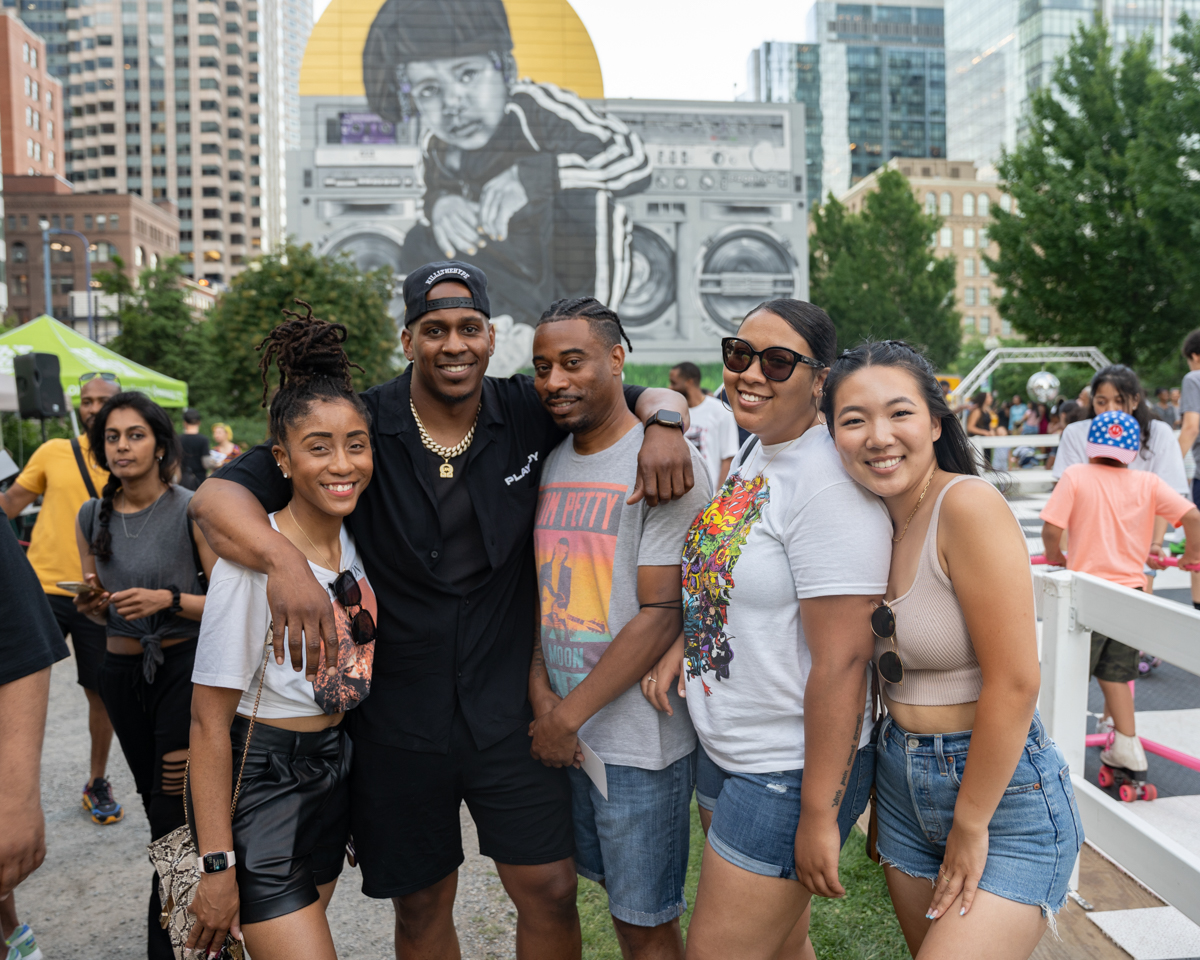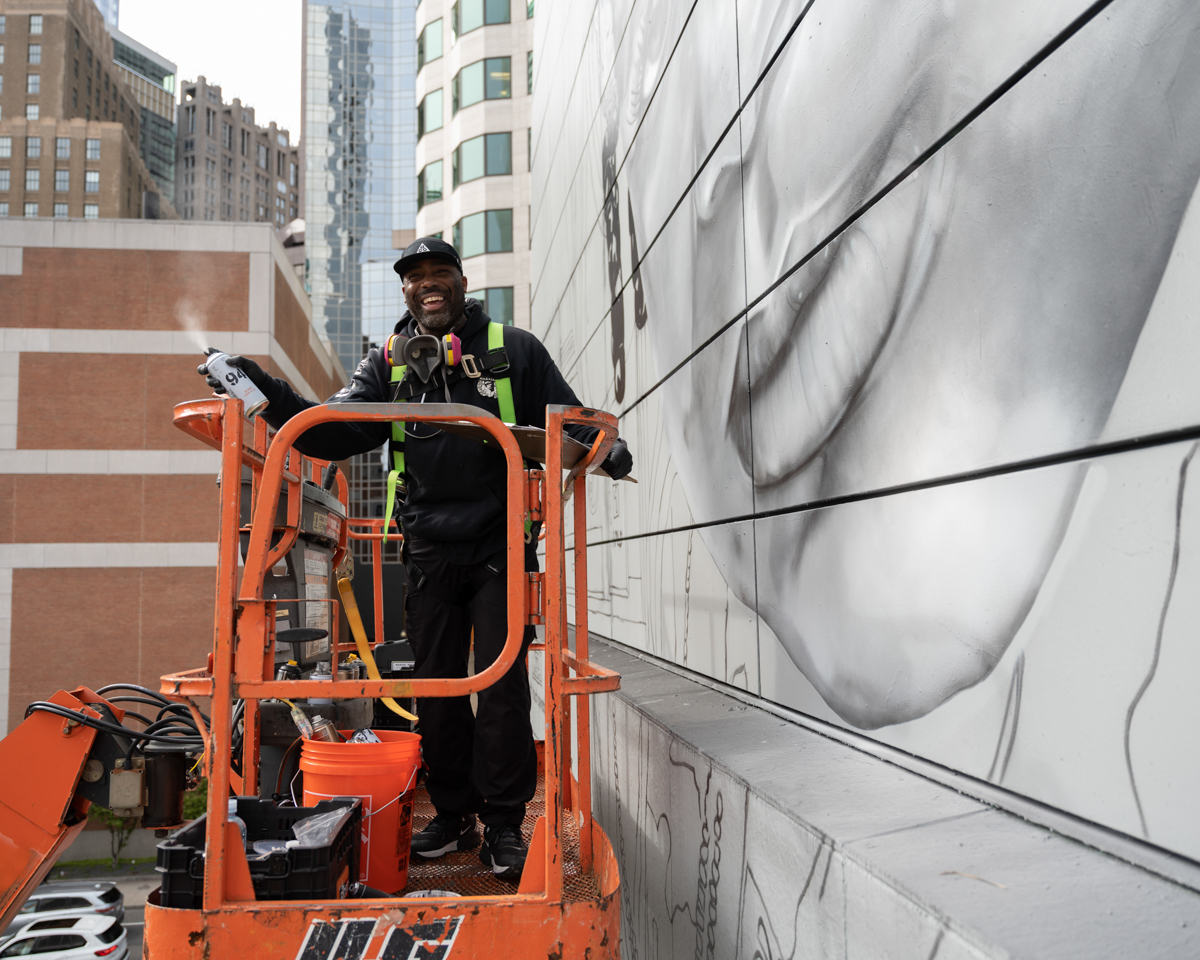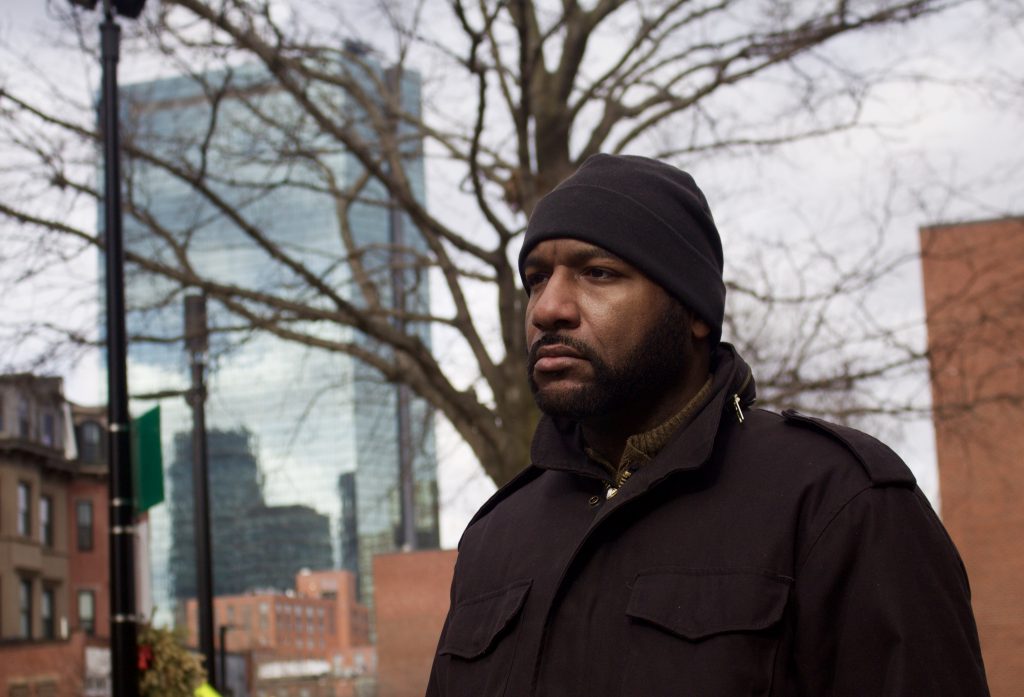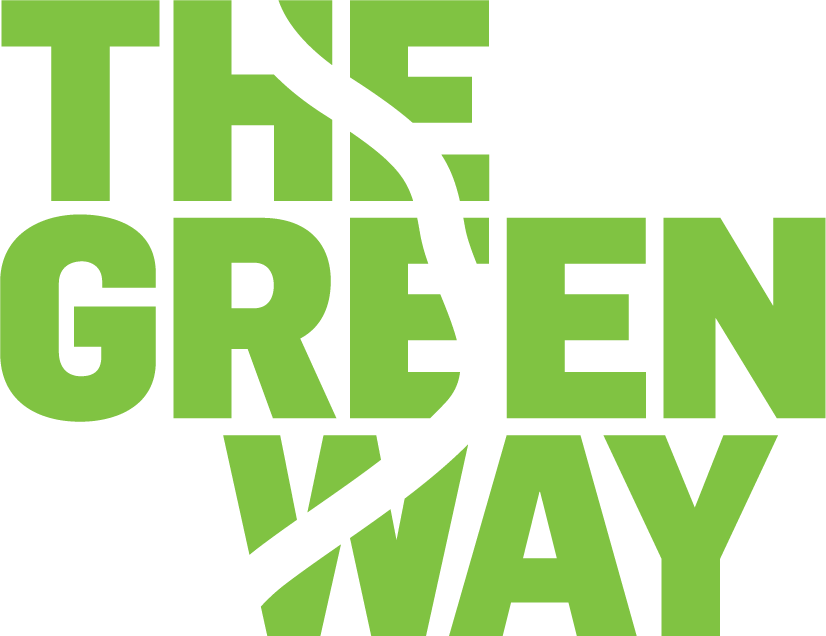

Last summer, as we prepared to transition from our “Breathe Life Together” mural by Rob “ProBlak” Gibbs (@problak) to our new mural by Jeffrey Gibson, our Public Art Team commissioned two essays by local writers to share what the previous mural from Problak had meant to them as Black creatives and residents of Boston.
Dart Adams, a local historian and writer, and Arielle Gray, a reporter with WBUR and artist, wrote powerful essays describing how ProBlak’s work allowed the Black community to feel a sense of belonging and union within the greater landscape of Boston.
“Boston is experiencing a building boom for luxury condos and high rises but not for affordable housing,” Adams writes. “We’ve experienced heavy gentrification where the former displaced population has been priced out of a neighborhood, changing its demographic. In these instances, we often experience the history of an entire stretch of the city being overwritten in less than a decade. This once again creates an environment where people of all ages are unsure of their place in the city, don’t feel valued, or see themselves or their culture being acknowledged or valued. To combat that, PROBLAK and his many collaborators and contemporaries have placed murals all over the walls of schools, businesses, public parks, and the sides of buildings all along Boston’s neighborhoods. The Rose Kennedy Greenway, however, is another matter entirely…”
Read Adam’s full essay, and a brief Q&A about his reflections below, and click here to read Gray’s essay. If you, too, have felt a positive connection to ProBlak’s mural, we’d love to hear from you at [email protected]
Q&A with the Rose Kennedy Greenway & Dart Adams
Q: Your essay shows that even from a young age, you had a strong understanding of the importance of both personal and collective history, and that you have taken pride in how public art showcased these narratives within your community. Can you share a little about why you feel that supporting inclusive art experiences in public spaces is essential to continuing to advance conversations around difficult and sometimes divisive issues? What conversations would you encourage us to embark upon with our neighbors?
A: Myself and my peers benefited from feeling seen and represented by the public art not just in our neighborhoods in the form of murals, but also in our community centers and schools. Most of the schools I went to were built in the late ’70s like the Blackstone and Josiah Quincy. Outside and inside of these schools you could find murals and public art pieces made by the kids in the neighborhood and those who were the first to be enrolled there. It fostered a sense of belonging, that you were a part of this school and it was a part of the community. These public spaces served the community and the inclusivity of the art helped to bridge cultural and racial divides among the student body so everyone felt seen and valued.
Q: In your essay, you write “The same sense of purpose and belonging and feelings of pride and empowerment that struck me as a child when I saw Gary Rickson and his contemporaries’ murals and public art pieces all over South End/Lower Roxbury, Roxbury, and Dorchester came rushing back as an adult. I looked around and I was far from alone.” Following that, you noted that the artwork made a statement. What statement did the artwork make in your eyes, and what can we as a community do to carry forward that sense you had that day of togetherness, connectedness, and purpose without the visual reminder of a mural?
A: I feel as though the art I saw in my neighborhood helped to spark the creativity of myself and my peers who also pursued visual arts, many opted to do that through the medium of graffiti and aerosol art but it served as a gateway towards traditional art. We had artists like Allan Rohan Crite, Dana Chandler, Paul Goodnight, Gary Rickson but also the Harriet Tubman House and Children’s Art Center to teach us the importance of expression. My hope is the artistic output made by my friends, peers and their contemporaries continues to inspire future generations of creatives the way we were.
Q: Can you share your vision for an inclusive and supportive community space (here in Boston)? What would it mean to you to see all communities made to feel welcome and for all people to have equitable access to free public programming, green space, the arts, and other experiences that can enrich our daily lives?
A: Boston is a city comprising between 23 to 25 neighborhoods and no matter how different we may be, one thing that’s universal is the need and want for beautiful, accessible, multipurpose public spaces for people to enjoy. Art, music, and culture are for everyone and everyone of all ages, ethnicities, nationalities and races can appreciate art. It’s a universal language we all share.

Reflections on “Breathe Life Together” by Dart Adams
Growing up in the South End/Lower Roxbury, I’ve been told a great deal of stories about the neighborhood in my almost 49 years. Many of them involve how it was in my neighborhood between the 1940s and 1960s. The South End/Lower Roxbury was Boston’s most diverse section during that stretch of time. Home to Blacks, Latinos, Asians and White denizens alike in aging rooming houses. Many were poor working class, musicians, students or they worked on the railroad as Pullman porters.
I was told magnificent tales about everyone from Duke Ellington, Cab Calloway, Count Basie, Sabby Lewis, Miles Davis, to Malcolm X. Neighborhood elders informed me that Sammy Davis Jr., Quincy Jones, Martin Luther King Jr., and Coretta Scott King all lived in this very same neighborhood. I never read about this anywhere at the time and no one ever told these stories but the folks who dwelled on the main streets or the many Lower Roxbury/South End cross streets.
Even when I didn’t see myself or my neighbors represented in films and television shows about Boston, I felt seen by way of murals and pieces of public art in community schools such as the McKinley, Blackstone, and the Josiah Quincy School. I was entranced by a mural that was directly behind the Harriet Tubman House community center at the corner of Mass Ave. and Columbus Ave. It wasn’t until I was a little older that I discovered that the “RICKSON” painted on that wall referred to the artist, Gary Rickson.
Rickson singlehandedly ushered in an era of Afrocentric public art made by Black artists to empower and inspire the people of Boston’s inner city. He was a founding member and president of the Boston African American Artists Association–back when it was founded between 1968 and 1969 it was called the Boston Negro Artists Association–as well as the creator of Summerthing, an arts and culture program that brought exhibitions, concerts, and activities that reflected the diversity, history, and culture of the denizens of Boston’s neighborhoods.
By 1969, the first of these vibrant murals began to pop up on the walls of the South End, Lower Roxbury, Roxbury, and North Dorchester. They were impossible to miss and stuck out in the minds of the young children who regularly saw them during their formative years. They included Gary Rickson’s mural on the Roxbury YMCA titled “Africa Is The Beginning” made in 1969 and Sharon Dunn’s colorful love letter to the backbone of our communities, “Black Women,” which was painted on the side of civil rights leader Mel King’s home at 4 Yarmouth in Boston’s South End the same year.
Sharing the gift of public art, a sense of purpose and belonging
Rob “PROBLAK” Gibbs and I are from the same neighborhood, had mutual friends, similar interests, and shared many of the same creative inspirations and artistic reference points. By the time the late ‘80s rolled around, the overwhelming majority of murals and public art pieces that evoked feelings of neighborhood/community pride, Black empowerment, and representation in its residents were either painted or fading. The generation of young artists inspired by neighborhood heroes like Alan Rohan Crite, Gary Rickson, Ekua Holmes, and the Black Arts Movement sought to combat the urban decay and blight of their neighborhoods. They sought to carry on the tradition of beautifying Boston’s urban neighborhoods with murals featuring bright, vibrant, depictions of city life and culture to combat the vacant lots and neglect caused by years of Republican presidents and the ravages of the Crack Era.
Boston has long since emerged from the era full of bare plots of land, empty parcels that weren’t built on, and abandoned properties that were in abundance throughout the late ‘80s to the mid ‘90s. During that time, crews of aerosol artists like ALA (African Latino Alliance) and GN (Graff Nuts) were being commissioned to paint walls in the South End/Lower Roxbury, Roxbury, Dorchester, and beyond. They carried on the tradition of the artists who emerged in the late ’60s through the mid ‘70s who gave them the impetus to share the gift of public art that can give future generations a sense of purpose and belonging in what can often feel like a harsh, cold, and uncaring city. Boston is experiencing a building boom for luxury condos and high rises but not for affordable housing. We’ve experienced heavy gentrification where the former displaced population has been priced out of a neighborhood, changing its demographic. In these instances, we often experience the history of an entire stretch of the city being overwritten in less than a decade. This once again creates an environment where people of all ages are unsure of their place in the city, don’t feel valued, or see themselves or their culture being acknowledged or valued. To combat that, PROBLAK and his many collaborators and contemporaries have placed murals all over the walls of schools, businesses, public parks, and the sides of buildings all along Boston’s neighborhoods. The Rose Kennedy Greenway, however, is another matter entirely.
Boston: a city steeped in traditions
We’ve seen Boston change by leaps and bounds over the past 20 years, but this city is steeped in traditions and staples that often go back more than a hundred years. Boston’s vaunted and much celebrated Emerald Necklace public park system which was created and tied together between the 1860s and 1890s didn’t feature art or statutes for Bostonians of color so when I walked the Commonwealth Avenue Mall as a kid, I didn’t feel the same walking the South End/Lower Roxbury blocks as I did in the nearby Back Bay. The Rose Kennedy Greenway, which was opened to the public in 2008 has dedicated itself to feature and highlight art and murals made by local creatives to showcase the diverse ethnicities, cultures, and backgrounds found in Boston’s 25 neighborhoods.
The Greenway is nestled between multiple high-rise buildings, these structures represent a “new” Boston amidst its almost 400 years of history. It sits at the intersection of Boston’s Leather District, Financial District, Chinatown, Downtown Crossing, the Boston Harbor, Fort Point & the Waterfront. The Greenway is across the street from South Station, the MBTA’s busiest station where thousands of people daily ride through the Metro Boston Area or travel to or arrive in Boston from elsewhere. Seeing PROBLAK’s mural featuring his daughter in her B-Girl crouch rocking both the official Hip Hop and inner-city Boston uniform in a black Kangol, black Adidas tracksuit with white stripes, and shelltoe Adidas behind a massive boombox is a sight I quite honestly never thought would be possible in my lifetime as a Boston resident.
The same sense of purpose and belonging and feelings of pride and empowerment that struck me as a child when I saw Gary Rickson and his contemporaries’ murals and public art pieces all over South End/Lower Roxbury, Roxbury, and Dorchester came rushing back as an adult. I looked around and I was far from alone. I scanned the faces of people who saw it for the first time and they all loved it. “Breathe Life Together” resonated with small children, teenagers, adults, the elderly, and people from every imaginable background. They all look up and see a child’s face surveying the city. I’ve witnessed people stop dead in their tracks on their way elsewhere to get a better look or take a picture to share with others on social media.
In closing, “Breathe Life Together” accomplished what all great art sets out to do, connect with people, build community with them, and ultimately bring them together to appreciate life while making a statement. Mission accomplished.
Dart Adams is a native Bostonian journalist, historian, lecturer, researcher, and author. He is the host of the podcasts Dart Against Humanity and Boston Legends. His work has appeared in various online and print publications including Complex, NPR, Mass Appeal, Okayplayer, Ebony, LEVEL, The Emancipator, The Bay State Banner, Boston Globe, Boston Globe Magazine, and Boston Magazine. Dart’s books include “Instead We Became Evil: A Palestinian Refugee’s True Story Of Survival & Perseverance” and the upcoming “On Track: The Kronicles Of DJ Amir.”
Photo credit: First two photographs taken by G. Ortiz on 6/25/22 at the Breathe Life Together Block Party, portrait of Dart Adams by Eileen O’Grady



